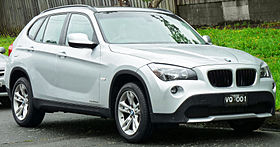Something about

In 2006, the BMW group (including Mini and Rolls-Royce) produced 1,366,838 four-wheeled vehicles, which were manufactured in five countries.[19] In 2010, it manufactured 1,481,253 four-wheeled vehicles and 112,271 motorcycles (under both the BMW and Husqvarna brands).[2] The BMW X3 (E83) was made by Magna Steyr, a subsidiary of Magna of Canada, in Graz, Austria under license from BMW until 2010. More than 45,973 were produced in 2009. Starting October 2010, the new BMW X3 (F25) is produced in BMW's plant in Spartanburg, South Carolina, U.S.A. It is reported that about 56% of BMW-brand vehicles produced are powered by petrol engines and the remaining 44% are powered by diesel engines. Of those petrol vehicles, about 27% are four-cylinder models and about nine percent are eight-cylinder models.[20] BMW also has local assembly operation using complete knock down components in Thailand, Russia, Egypt, Indonesia, Malaysia, and India, for 3, 5, 7 series and X3 BMW began building motorcycle engines and then motorcycles after World War I.[21] Its motorcycle brand is now known as BMW Motorrad. Their first successful motorcycle, after the failed Helios and Flink, was the "R32" in 1923. This had a "boxer" twin engine, in which a cylinder projects into the air-flow from each side of the machine. Apart from their single-cylinder models (basically to the same pattern), all their motorcycles used this distinctive layout until the early 1980s. Many BMWs are still produced in this layout, which is designated the R Series. In 2004, BMW introduced the new K1200S Sp

rts Bike which marked a departure for BMW. It features an engine producing 167 hp (125 kW), derived from the company's work with the Williams F1 team, and is lighter than previous K models. Innovations include electronically adjustable front and rear suspension, and a Hossack-type front fork that BMW calls Duolever. BMW introduced anti-lock brakes on production motorcycles starting in the late 1980s. The generation of anti-lock brakes available on the 2006 and later BMW motorcycles pave the way for the introduction of electronic stability control, or anti-skid technology later in the 2007 model year. BMW has been an innovator in motorcycle suspension design, taking up telescopic front suspension long before most other manufacturers. Then they switched to an Earles fork, front suspension by swinging fork (1955 to 1969). Most modern BMWs are truly rear swingarm, single sided at the back (compare with the regular swinging fork usually, and wrongly, called swinging arm). Some BMWs started using yet another trademark front suspension design, the Telelever, in the early 1990s. Like the Earles fork, the Telelever significantly reduces dive under braking. In July 2007, the Italian-made Husqvarna Motorcycles was purchased by BMW for a reported €93 million. BMW Motorrad plans to continue operating Husqvarna Motorcycles as a separate enterprise. All development, sales and production activities, as well as the current workforce, have remained in place at its present location at Varese.[22] Husqvarna manufactures motocross, enduro and supermoto motorcycles.
.jpg)